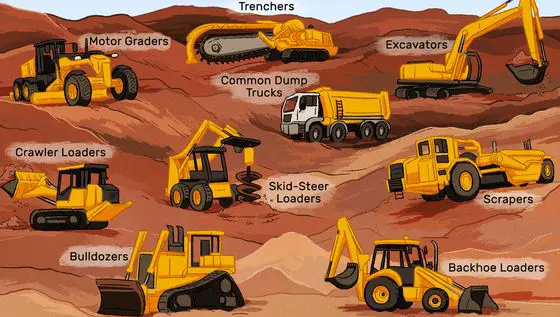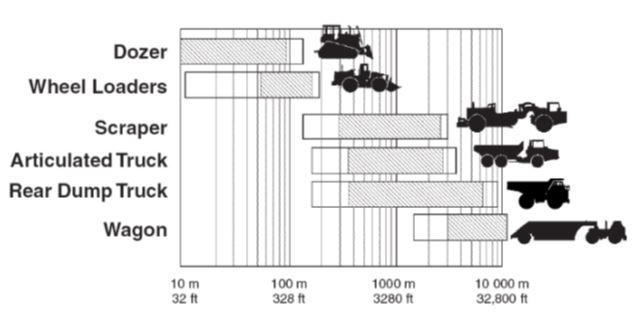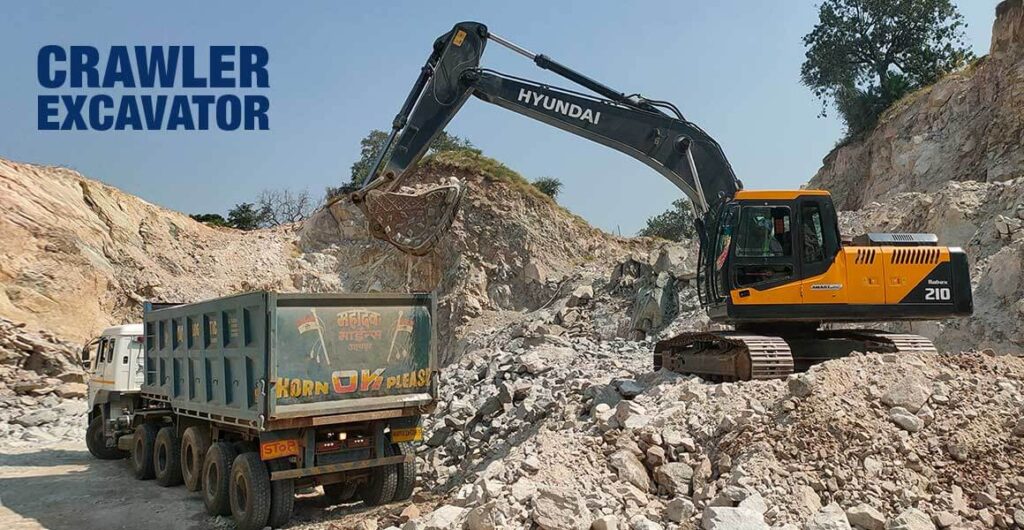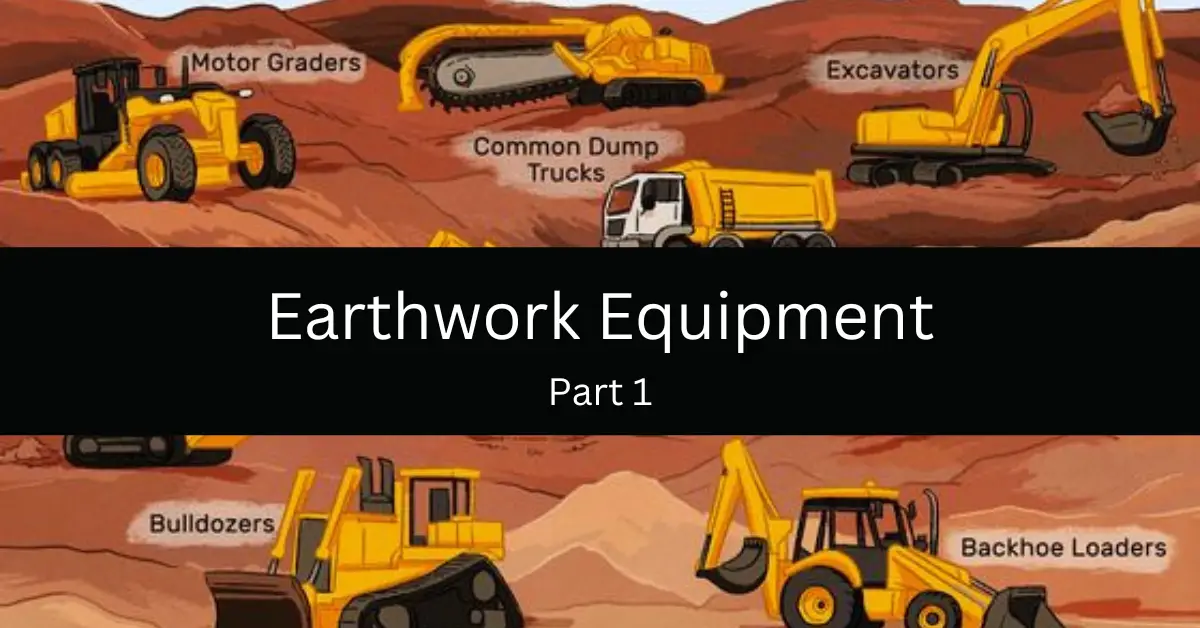Let’s learn about the most common types of earthwork equipment used in construction work, their features, applications, and aspects to consider when utilizing them in this post.
Table of Contents
What are the equipment used in earthwork?
The nature of the work will determine the type of equipment used in earthwork.
Bulldozers, bucket scrapers, power shovels or excavators, backhoes, and draglines are some of the most common excavation equipment.
Factors influencing the selection of earth moving equipment
- The amount of material to be moved.
- The types and physical properties of excavated materials.
- If excess earthwork or excavated material is unsuitable and must be discarded.
- The ability of equipment to move across terrain.
- The haul distances, construction, and slopes of haul routes required for the available types of equipment.
- The probabilities of encountering variable weather conditions.
- If there are restrictions on the use of earth-moving equipment on public roads.
- The types of available equipment and whether or not plant will be rented or obtained from the contractor’s central plant depot.

General haul distances chart for earthwork equipment

General purpose excavator loader/ Loader back hoe (JCB)
The Excavator is composed of an articulated arm (boom, stick), bucket, and cab positioned on a pivot above a track or wheeled undercarriage.
The excavator/loader may be driven to the site on public roads because it is tyre mounted.
As long as the ground is firm, the tyres also allow it to move quickly.
It has a hydraulic shovel that is moved by hydraulics as well as a hydraulic back-acting mechanism for digging.
Excavation for footings, drainage trenches, and other site work are the three most typical applications.
This system has the obvious advantage that the operator can clearly see the excavation and regulate how far it goes.
This equipment is particularly adaptable because it may be fixed with buckets of varying widths and numerous additional accessories.
For general purpose common excavation, loading into lorries, and grading excavations while moving materials, use the hydraulically driven shovel.

Excavator Applications
- Trenching operations
- Holes/pits/foundations
- Material management
- Hydraulic drilling
- Attachments for hydraulic breakers are utilized for demolition.
- General grading/landscaping
- Heavy load (e.g. lifting and placing of pipes)
- Mining, notably open-pit mining but not limited to it.
- River dredging
Backhoes or excavators are other names for these back-acting excavators.
In most cases, they have tracks rather than wheels.
This has the advantage of distributing the machine’s weight evenly, allowing it to operate on uneven terrain.
Operating a tracked excavator takes a little longer than one with tyres.
For transportation to and from the site, a low-loader is necessary.
Backhoes or excavators are other names for these back-acting excavators.
In most cases, they have tracks rather than wheels.
This has the advantage of distributing the machine’s weight evenly, allowing it to operate on uneven terrain.
Operating a tracked excavator takes a little longer than one with tyres.
For transportation to and from the site, a low-loader is necessary.
The arm holding the bucket is lowered while digging, and the bucket’s teeth are drawn towards the direction of the operator’s cab.
The bucket is rotated as it fills with soil to prevent material loss, hoisted away from the excavation, and then inverted to release the burden.
The largest excavators of this type can dig down around 6 m below the level of the tracks.

The Front Shovel/Face Shovel
The load is then swung away from the excavation and dropped by opening the bucket. The excavation is up against a face of earth.
Over distances of more than 1.5 km, using face shovels and dump trucks in tandem is typically the most economical method of digging and moving soil.
It’s crucial to match the face shovel bucket’s capacity to the size of the dump trucks so that each dumper can hold three or four loaded buckets.
Shovel Production
Cycle element times for 3-5 cu. yd. shovels under typical conditions;
| Shovel cycle element | Expected time |
| Load bucket | 7 to 9 sec. |
| Swing with load | 4 to 6 sec. |
| Dump Load | 2 to 4 secs. |
| Return swing | 4 to 5 sec. |
When digging and loading, it’s critical to keep in mind that a shovel is stationary.
The only movement allowed during excavation is into or along the face.
There are several variables that can determine the production of a shovel, including
- Material Class
- Cut height
- Swing angle
- Hauling unit size
- Operator competence
- Shovel’s physical condition
Production efficiency is about 30–45 minutes per hour.
If the face that the shovel is pulling material from is too low, it will be hard or impossible to fill the bucket in one pass up the excavation face.
The operator will be able to take a partially filled bucket to the hauling unit with each cycle, or he can make many passes to fill the bucket, which will lengthen the cycle duration. In either scenario, the result will be a decrease in shovel production.
The swing angle between the bucket’s excavation position and its discharge point is represented in degrees.
Tables for Backhoe
Fill factors for backhoe bucket
| Material | Percentage fill factor |
| Moist loam or sandy clay | 100-110 |
| Sand and gravel | 95-100 |
| Hard, tough clay | 80-90 |
| Rock, well blasted | 60-75 |
| Rock, poorly blasted | 40-50 |
Probable output of backhoe
| Bucket payload, cy loose measure | Output of backhoe, cy/hr loose measure |
| ½ | 75-135 |
| ¼ | 90-202 |
| 1 | 120-270 |
| 1 ¼ | 150-300 |
| 1 ½ | 154-360 |
| 1 ¾ | 180-420 |
| 2 | 205-420 |
| 2 ¼ | 231-472 |
Correction factor for Optimum depth of cut angle of swing












